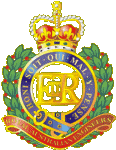Steele Memorial Gates
The Steele Memorial Gates which stood at the entrance to SME Casula since 1956 have been relocated to the new Steele Lines and now form the backdrop at the front of the parade ground.
The Memorial Gates are symbolic of the bridge conceived and designed by Maj Gen Sir Clive Steele (then Brig) KBE,DSO, MC, VD. The bridge was manufactured in Australia during WWII when Bailey Bridge supplies were unavailable.
With spans up to 120 ft, the Steele Bridge proved to be invaluable in the South West Pacific campaigns until the more sophisticated and expensive Bailey and Australian Panel bridges became available
Street Names
Road names within the Steele Lines all relate to place names associated with Engineers and campaigns in which Australian Sappers served. They include:
Chatham Ave
Chatham is the home of RSME, name retained from Steele Barracks, Casula NSW
Peshawar Rd
UN Mine Clearance Training Team (UNMCTT) HQ based in Peshawar, Pakistan until December 1993
Birr Cross Rd
AE sappers built planked roads and small gauge rail lines near here during WW1, France
Fortuna Rd
Was the home of Survey Corps largest unit, the Army Survey Regiment in Bendigo, Victoria
Jacquinot Ct
Jacquinot Bay was base to 4, 12 & 13 Fd Coys during WW2 and is located on the island of New Britain
Chora Valley Way
Reconstruction Task Force 3 (RTF 3) built FOB in the valley. Located in Uruzgan Province of Afghanistan
Namibia Rd
An ADF contingent deployed as part of UNTAG to Namibia during period 1989-1990
Bulldog Rd
114km road built from Wau to Bulldog, New Guinea during WW2
Keningau Rd
Keningau was home base for units deployed to Sabah, Borneo from 1964 to 1966
Long Hai Rd
Barrier minefield laid in Long Hai hills west of Nui Dat in Phuoc Tuy Province, SVN
Tarakan Ct NSW
Beach obstacle clearance in 1945 during WW2 on Tarakan Island, name retained from Steele Barracks, Casula
Long Hai Rd
Barrier minefield laid in Long Hai hills west of Nui Dat in Phuoc Tuy Province, SVN
Bobonaro Rd
3 CER main base was located at Maliana in Bobonaro district during INTERFET in 1999
Wewak Pl
100 miles road, 118 bridges built from Aitape to But to Wewak, New Guinea during WW2
Haifa Rd
176 miles rail line built between Haifa – Beirut – Tripoli during 1941 – 1942 in Middle East during WW2
Museum
The new purpose designed and constructed museum was officially opened by Maj Gen Stephen Day DSC, AM on 26th June 2015, the same day as the Steele Lines were opened. Maj Gen Day was our senior serving Sapper at the time of opening the museum.
The new museum is able to display a greater array of Engineer memorabilia and equipment. So great is the collection that not all items are able to be displayed at the one time.
The Archive Collection of books, documents, maps, photographs and audio visual material is not on display and is closed to the public. Access to this material for research purposes can be arranged with the Museum Curator.
The Bicentennial Building, designed by Engineers and constructed by 17 Construction Squadron in 1987, became a casualty of the move to Holsworthy. The building is a part of the buildings remaining at the old Casula site to be demolished during the redevelopment.
The Dioramas depicting – Colonial Engineers pre 1900, Mine warfare Western Desert, Demolition Scene, Bomb Disposal, all WWII dioramas and Tunnel Warfare Vietnam – were not included in the move.
All the other artefacts/objects that were on display in the Bicentennial Building have been retained as part of the museum collection.
The etched glass panel depicting the RAE Corps hat badge is currently with the museum collection and will most likely go on display in the new HQ building.
The success of the Museum and the growth of the collection is dependent on the support of current and former sappers and their families and Engineer Units to contribute to the collection.
As the museum is on military property, access to the museum by the general public must be arranged in advance and can be coordinated by contacting the museum on 02 8782 8822 or [email protected]
RAE Memorial Chapel
The RAE Memorial Chapel stands alongside the SME HQ building.
Work on the Chapel started in 2014 and some of the sandstone blocks from the old Chapel were able to be reclaimed and built into the new Chapel.
The old SME Chapel was deconsecrated in 2015 when the Casula site closed down and the new Chapel was consecrated soon after. The name “All Saints” was retained.
All of the ‘donated’ items, like the Baptismal Font which was donated by the Western Command Engineers (Perth WA), and other loose items of significance were transferred to the new Chapel, although not all are on displayed at this time.
The original Chapel was designed by Col D A Davey and Capt J M Brindley and construction by adult tradesmen and Army Apprentice tradesmen under the supervision of the Apprentice Master.
The stone used in the construction was convict hand cut stone from the Bow-Bowing Flour Mill (circa 1855) in Campbelltown, from Victoria Barracks, Sydney and on old married quarter at Holsworthy built by German POW’s during WW1.
RAE Corps Shop
The Corps shop is currently co-located with the museum and may be relocated at a later date.

